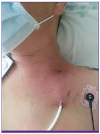1. Malani AN, Kauffman CA. Changing epidemiology of rare mould infections: implications for therapy. Drugs. 2007; 67:1803–1812.
2. Auberger J, Lass-Florl C, Aigner M, Clausen J, Gastl G, Nachbaur D. Invasive fungal breakthrough infections, fungal colonization and emergence of resistant strains in high-risk patients receiving antifungal prophylaxis with posaconazole: real-life data from a single-centre institutional retrospective observational study. J Antimicrob Chemother. 2012; 67:2268–2273.

3. Kang SH, Kim HS, Bae MN, Kim J, Yoo JY, Lee KY, Lee DG. Fatal breakthrough mucormycosis in an acute myelogenous leukemia patient while on posaconazole prophylaxis. Infect Chemother. 2015; 47:49–54.

4. Bayramoglu G, Sonmez M, Tosun I, Aydin K, Aydin F. Breakthrough
Trichosporon asahii fungemia in neutropenic patient with acute leukemia while receiving caspofungin. Infection. 2008; 36:68–70.

5. Asada N, Uryu H, Koseki M, Takeuchi M, Komatsu M, Matsue K. Successful treatment of breakthrough Trichosporon asahii fungemia with voriconazole in a patient with acute myeloid leukemia. Clin Infect Dis. 2006; 43:e39–41.
6. Clinical and Laboratory Standards Institute (CLSI). Reference method for broth dilution antifungal susceptibility testing of yeast; 4th informational supplement, M27-S4. Wayne, PA: CLSI;2012.
7. Colombo AL, Padovan AC, Chaves GM. Current knowledge of
Trichosporon spp. and Trichosporonosis. Clin Microbiol Rev. 2011; 24:682–700.

8. Arendrup MC, Boekhout T, Akova M, Meis JF, Cornely OA, Lortholary O. European Society of Clinical Microbiology and Infectious Diseases Fungal Infection Study Group. European Confederation of Medical Mycology. ESCMID and ECMM joint clinical guidelines for the diagnosis and management of rare invasive yeast infections. Clin Microbiol Infect. 2014; 20:Suppl 3. 76–98.

9. Dua V, Yadav SP, Oberoi J, Sachdeva A. Successful treatment of
Trichosporon asahii infection with voriconazole after bone marrow transplant. J Pediatr Hematol Oncol. 2013; 35:237–238.

10. Ruan SY, Chien JY, Hsueh PR. Invasive trichosporonosis caused by Trichosporon asahii and other unusual Trichosporon species at a medical center in Taiwan. Clin Infect Dis. 2009; 49:e11–e17.
11. Liao Y, Hartmann T, Ao JH, Yang RY. Serum glucuronoxylomannan may be more appropriate for the diagnosis and therapeutic monitoring of Trichosporon fungemia than serum β -D-glucan. Int J Infect Dis. 2012; 16:e638.
12. Suzuki K, Nakase K, Kyo T, Kohara T, Sugawara Y, Shibazaki T, Oka K, Tsukada T, Katayama N. Fatal Trichosporon fungemia in patients with hematologic malignancies. Eur J Haematol. 2010; 84:441–447.
13. Menezes EA, Marinho JA, Angelo MR, Cunha Mda C, Cunha FA, Vasconcelos Júnior AA. Isolation and antifungal susceptibility testing of
Trichosporon asahii in Ceará, Brazil. Rev Inst Med Trop São Paulo. 2012; 54:1–3.

14. Nachbaur D, Angelova O, Orth-Höller D, Ditlbacher A, Lackner M, Auberger J, Lass-Flörl C. Primary antifungal prophylaxis with micafungin in patients with haematological malignancies: real-life data from a retrospective single-centre observational study. Eur J Haematol. 2015; 94:258–264.

15. Chen J, Chen F, Wang Y, Yang LY, Miao M, Han Y, Wu DP. Use of combination therapy to successfully treat breakthrough
Trichosporon asahii infection in an acute leukemia patient receiving voriconazole. Med Mycol Case Rep. 2014; 6:55–57.

16. Kim YJ, Kim SI, Kim YR, Park YM, Park YJ, Kang MW. Successful treatment of septic shock with purpura fulminans caused by Trichosporon asahii in an immunocompetent patient. Ann Clin Lab Sci. 2007; 37:366–369.
17. Rieger C, Geiger S, Herold T, Nickenig C, Ostermann H. Breakthrough infection of
Trichosporon asahii during posaconazole treatment in a patient with acute myeloid leukaemia. Eur J Clin Microbiol Infect Dis. 2007; 26:843–845.

18. Jang MJ, Lee YK, Han KC, Hong SG, Kang MS, Oh D, Chong SY. A case of Trichosporon beigelii fungemia treated with mphotericin B and fluconazole in a patient with acute myelogenous leukemia. Korean J Hematol. 2004; 39:109–112.
19. Shimono J, Tsutsumi Y, Ohigashi H. Acute renal tubular damage caused by disseminated Trichosporon infection in primary myelofibrosis. Rinsho Ketsueki. 2015; 56:21–24.
20. Matsue K, Uryu H, Koseki M, Asada N, Takeuchi M. Breakthrough trichosporonosis in patients with hematologic malignancies receiving micafungin. Clin Infect Dis. 2006; 42:753–757.








 PDF
PDF ePub
ePub Citation
Citation Print
Print





 XML Download
XML Download